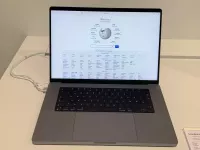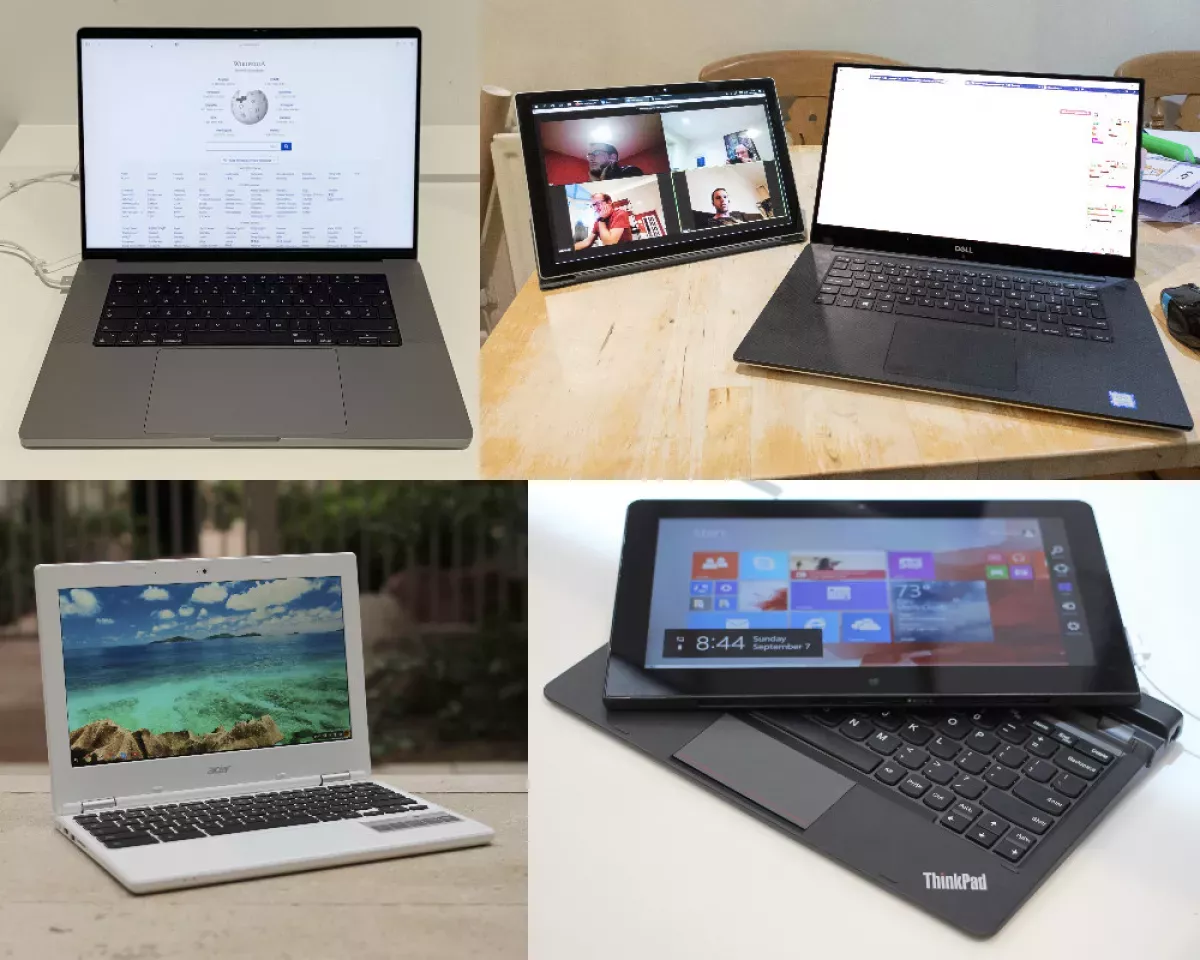A laptop, or notebook computer, is a small and portable personal computer. Typically featuring a clamshell design, it integrates a flat-panel screen in the upper lid and a keyboard and pointing device in the lower lid. Internal hardware resides beneath the keyboard. Modern laptops often include built-in webcams and sometimes touchscreens. Unlike tablets, laptops generally utilize desktop operating systems, originally designed for desktop computers.
1968: Alan Kay imagined a portable information manipulator
In 1968, Alan Kay at Xerox PARC imagined a "personal, portable information manipulator," later described as the "Dynabook" in his 1972 paper.
1972: Alan Kay described the Dynabook
In 1972, Alan Kay described his vision of a portable computer as the "Dynabook" in his paper.
1973: IBM SCAMP prototype demonstrated
In 1973, IBM demonstrated the Special Computer APL Machine Portable (SCAMP), a prototype based on the IBM PALM processor.
September 1975: IBM 5100 released
In September 1975, IBM released the IBM 5100, the first commercially available portable computer, based on the SCAMP prototype.
July 1980: Epson HX-20 invented
In July 1980, the first "laptop-sized notebook computer", the Epson HX-20, was invented by Yukio Yokozawa of Suwa Seikosha.
1981: Epson HX-20 introduced at COMDEX
In 1981, Seiko Epson introduced the Epson HX-20 at the COMDEX computer show in Las Vegas.
July 1982: Epson HX-20 released
In July 1982, the Epson HX-20, the first "laptop-sized notebook computer", was released. It featured an LCD screen, rechargeable battery, and a calculator-size printer.
1982: GRiD Compass 1101 released
In 1982, the GRiD Compass 1101 was released and used by NASA and the military.
1982: Notebook term emerged
In 1982, the term "notebook" emerged to describe Epson's HX-20 portable computer.
1983: Sharp PC-5000 released
In 1983, the Sharp PC-5000 was released.
1983: Earliest attestation of laptop
In 1983, the earliest attestation of the term "laptop" was found by the Oxford English Dictionary.
1983: Touch pad introduced
In 1983, the touch pad was developed and included in laptops, first seen on the Gavilan SC.
1984: Dulmont Magnum marketed internationally
In 1984, the Dulmont Magnum was marketed internationally.
1984: Laptop term origin traced
The etymologist William Safire traced the origin of "laptop" to some time before 1984.
1985: Ampere WS-1 and Gavilan SC released
In 1985, the Ampere WS-1 and Gavilan SC were released.
1986: Low market share of battery-powered portable computers
In 1986, battery-powered portable computers had only a 2% worldwide market share.
1987: Handwriting recognition introduced
In 1987, handwriting recognition was introduced on laptops, featured on the Linus Write-Top.
1988: VGA resolution reached
By 1988, laptop displays reached 640x480 (VGA) resolution with the Compaq SLT/286.
1988: Notebooks emerged as a separate market
In 1988, Notebooks emerged as their own separate market from laptops with the release of the NEC UltraLite.
1989: Leading Laptop Vendors in 1989
In 1989, Zenith Data Systems, Toshiba, Compaq, and Grid Systems were recognized as the leading vendors in the laptop market, which was described by InfoWorld as 'small but vital'.
1989: PCMCIA industry association created
In 1989, the Personal Computer Memory Card International Association (PCMCIA) was established to standardize memory cards for PCs.
1990: 2.5" hard drives introduced
Around 1990, 2.5" and smaller hard drives were introduced, becoming common in laptops, with capacities typically lagging behind desktop drives.
1990: Prevalence of 2.5-inch hard drives
Around 1990, laptops with hard drives typically used 2.5-inch drives, with some compact models supporting even smaller 1.8-inch HDDs and a very small number using 1" Microdrives.
1990: Laptops typically had a hard disk drive
Between 1990 and 2009, almost all laptops typically had a hard disk drive (HDD) for storage.
1990: Low-power CPUs developed
In 1990, CPUs like the Intel i386SL were designed to minimize power consumption for improved battery life in portable computers.
1990: Laptops accounted for one twentieth of the PC market
In 1990, laptops accounted for one-twentieth of the personal computer market.
1990: Macintosh portable used in space
In 1990, the first commercial laptop used in space was a Macintosh portable on Space Shuttle mission STS-41.
1990: PCMCIA type I cards specification released
In 1990, the specification for PCMCIA type I cards, later renamed PC Cards, was first released.
1991: Macintosh portable used in space again
In 1991, a Macintosh portable was used again on Space Shuttle mission STS-43.
1991: Color screens became common
In 1991, color screens started becoming a common upgrade in laptops.
1992: Toshiba as Global Leading Vendor
Between 1992 and 1993, Toshiba ranked as the global leading vendor in the notebook computer market.
1992: Laptop market grew rapidly
By 1992, the laptop market was growing about three times faster than that of desktops.
1992: Pointing stick introduced
In 1992, the pointing stick was introduced on laptops, featured on the IBM ThinkPad 700.
1993: Market Leadership in the US
In the United States between 1992 and 1993, Apple led the notebook computer market, followed by Compaq. In 1993, global revenue for the laptop market was led by Compaq, followed by Toshiba, Apple, NEC, and IBM, accounting for over 53% of global revenue.
1994: Laptops accounted for one sixth of the PC market
By 1994 laptops accounted for one-sixth of the personal computer market, and were more profitable than desktops.
1996: Top notebook vendors in the US
In 1996, the top three vendors for notebooks in terms of market share in the United States were Toshiba, followed by Compaq, and then IBM.
1997: Optical disc drives became common
Around 1997, optical disc drives became common in full-size laptops, starting with CD-ROM drives.
1999: Toshiba's lead in worldwide laptop sales
In 1999, Toshiba was ranked first in worldwide laptop sales with a market share of 18.6%, followed by IBM, Compaq, and Dell.
2000: Proprietary memory modules used if memory was upgradable
Before 2000, most laptops used proprietary memory modules if their memory was upgradable.
2000: Socketed CPUs common in full-size laptops
Between around 2000 and 2014, most full-size laptops had socketed, replaceable CPUs.
2002: Dell's dominance in the US notebook market
In the first quarter of 2002, Dell controlled 25.2% of the notebook space in the United States market, ahead of Toshiba (13.6%) and Compaq (11.7%), which had been acquired by Hewlett-Packard (HP). Sony and IBM were in fourth and fifth place.
2003: 17" screen laptops introduced
By 2003, 17" screen laptops were introduced, marking a significant increase in screen size.
2004: Acer overtakes HP and IBM in EMEA
In 2004, Acer became the largest vendor of laptops in Europe, the Middle East, and Africa (EMEA) territories, overtaking HP and IBM.
May 2005: Average notebook price in May 2005
In May 2005, the average notebook sold for $1,131, while desktops sold for an average of $696.
2005: Acer Largest vendor in EMEA
In 2005, Acer remained the largest vendor of laptops in Europe, the Middle East, and Africa (EMEA) territories.
2005: Dell leads global notebook sales
In 2005, according to IDC, Dell was the top global vendor of notebooks with a market share of 17.29%, followed by HP (15.7%), Toshiba (10.96%), Acer (10.15%), and Lenovo (8.23%). Lenovo had acquired IBM that same year.
2006: Dominance of ODMs in laptop manufacturing
In 2006, seven major Original Design Manufacturers (ODMs) manufactured 7 out of every 10 laptops worldwide, with Quanta Computer holding 30% of the market share. Many major brands rely on ODMs for laptop design and manufacturing.
August 2008: Decline in laptop prices due to netbooks
Around August 2008, laptop prices decreased substantially due to low-cost netbooks, drawing an average of US$689 at U.S. retail stores.
2008: Introduction of SSDs matching laptop hard drive size
Around 2008, SSDs were introduced, matching the size and shape of laptop hard drives until the mid-2010s.
2008: Notebook shipments exceed desktops for the first time
The third quarter of 2008 marked the first time when worldwide notebook PC shipments exceeded desktops, with 38.6 million units versus 38.5 million units.
2009: Laptops typically had a hard disk drive
Between 1990 and 2009, almost all laptops typically had a hard disk drive (HDD) for storage.
2010: Integrated GPUs introduced by Intel
In 2010, Intel introduced integrated GPUs with the Core i-series of mobile processors.
2010: HP and Acer compete for top vendor of portable computers
In the first quarter of 2010, HP and Acer were the largest vendors of portable computers, including netbooks, with approximately 9 million units shipped each. Dell, Toshiba, Asus, and Lenovo followed, each with approximate sales of 5 to 6 million each. Apple, Samsung, and Sony sold under 2 million each.
2010: Desktop processors used in small-volume gaming laptops
Since around 2010, the practice of using desktop processors in laptops has been restricted to small-volume gaming models.
January 2011: AMD APU processors introduced
In January 2011, AMD introduced similar APU processors with integrated GPUs.
2011: ThinkPads aboard the International Space Station
As of 2011, over 100 ThinkPads were aboard the International Space Station (ISS) as the only long-duration flight-certified computer.
2011: Laptops with 120 Hz refresh rate appeared
In 2011, laptops like the Dell M17x and Samsung 700G7A started featuring a 120 Hz refresh rate.
2011: High-end laptops passed 10 GB RAM barrier
In the early 2010s, high end laptops such as the 2011 Samsung 700G7A passed the 10 GB RAM barrier, featuring 16 GB of RAM.
2011: Switchable graphics introduced
Since 2011, higher-end laptops intended for gaming or professional 3D work almost always involve switchable graphics to optimize power consumption and performance.
2011: Trend shifted against internal optical drives
Starting around 2011, the trend shifted against internal optical drives in laptops.
2012: MacBook Pro with Retina display introduced
Since the introduction of the MacBook Pro with Retina display in 2012, there has been an increase in the availability of "HiDPI" displays.

2014: Replacement of SSDs with smaller cards
Around 2014, smaller mSATA or M.2 cards increasingly replaced the larger SSDs in laptops.
2014: Socketed CPUs common in full-size laptops
Between around 2000 and 2014, most full-size laptops had socketed, replaceable CPUs.
2015: Apple MacBook's transition to USB-C
In 2015, Apple transitioned from multiple I/O ports to a single USB-C port on its MacBook. This port could be used for charging and connecting devices through adapters, however Apple has since transitioned back to using a number of different ports.
2015: Intel stopped offering interchangeable laptop CPUs
Since 2015, Intel has not offered new laptop CPU models with pins to be interchangeable, preferring ball grid array chip packages which have to be soldered.
2016: Adoption of smart batteries in laptops
Most 2016-era laptops use a smart battery, which is a rechargeable battery pack with a built-in battery management system (BMS). The smart battery can internally measure voltage and current, and deduce charge level and State of Health (SoH) parameters.
2018: Macs consistently used soldered NVME storage
Since 2018, Macs have consistently used soldered NVME storage integrated with the motherboard.
2020: HP and Lenovo tied for leading notebook vendor
As of the third quarter of 2020, HP and Lenovo were cited as the leading vendors for notebook computers, both with a share of 23.6% each. They were followed by Dell (13.7%), Apple (9.7%), and Acer (7.9%).
2021: Mainstream consumer laptop screen sizes
As of 2021, mainstream consumer laptops typically come with 11", 13", 14", 15" or 16" screens.
2022: Optical drives largely disappeared from laptops
As of 2022, internal optical drives have largely disappeared from laptops, though they remain available as external peripherals.
2023: Availability of low-cost laptops
As of 2023, a new laptop can be obtained for $299, attributed to inexpensive and low power Arm processors, less demanding operating systems such as ChromeOS, and SoCs.
2023: Laptop sales estimated at 166 million
In 2023, it was estimated that 166 million laptops were sold.
2024: Laptop and notebook terms used interchangeably
As of 2024, the terms laptop and notebook are used interchangeably in American English, while other dialects may prefer one term over the other.
2024: GRiD Compass 1101 original price equivalent in 2024
In 1982, the GRiD Compass 1101 had a price of US$8,150, which is equivalent to $26,550 in 2024.
2024: Laptops dominate personal computer sales
In the first quarter of 2024, approximately 64% of personal computers sold were laptops or detachable tablets.
2025: Typical laptop RAM configuration
As of 2025, 16 GB RAM is most common in laptops, with some lower-end models having 8 GB, and higher-end laptops potentially having 64 GB or more.
2025: HDDs essentially extinct in new laptops
As of 2025, HDDs are essentially extinct in new laptops, with SSDs becoming the standard for storage.
2025: HiDPI displays generally considered to be anything higher than 1920 pixels wide
As of 2025, HiDPI displays on laptops are generally considered to be anything higher than 1920 pixels wide. 4K is a common resolution, although QHD resolution is also a common option.
2025: Engineering workstations converging on a single CAMM slot
As of 2025, high end engineering workstations are converging on a single CAMM slot.
2025: Laptop memory removable or soldered
As of 2025, laptop memory may be removable or soldered to the motherboard, depending on the model. SO-DIMM slots are used for removable memory, with CAMM modules slated to address size and timing limitations.
2025: Powering Laptops via USB-C vs. Dedicated DC Connector
As of 2025, laptops are broadly divided between being powered only by USB-C connectors (including all Apple models) versus having a dedicated DC power connector; most systems since the mid-2010s that have both connectors can be powered by either.
2025: CPUs soldered on mainstream laptops
As of 2025, mainstream laptops from all processor lines have CPUs soldered on the motherboard.
2025: Mainstream laptop processor core counts
As of 2025, mainstream laptops typically have between 6 and 16 processor cores, with some high-end workstations having as many as 24. A few low end models still have 4 cores.
2025: Decline of optical disc drives in laptops
As of 2025, optical drives are virtually unknown in new laptops and when needed, they can be connected via USB instead. Previously, optical disc drives were nearly universal on full-sized models between the mid-1990s and the early 2010s.
2025: USB and External Monitor Ports
As of 2025, typical laptops feature several USB ports, and if they use older USB connectors instead of USB-C, they will typically have an external monitor port, almost always HDMI. An analog audio in/out port in a combined socket is common.
2025: Shift towards M.2 cards for storage
As of 2025, very few laptops contain space for 2.5" drives, primarily accepting only M.2 cards. Macs and a few ultraportable non-Mac laptops have storage soldered to the motherboard.
2025: Limited support for expansion cards
As of 2025, very few laptops support expansion cards, with the primary means of expansion being via USB-C or Thunderbolt.
2025: NVME solid-state drives used for storage
As of 2025, virtually all laptops use NVME solid-state drives for storage, typically in M.2 slots on non-MacOS laptops.
2025: Processors soldered to the motherboard
As of 2025, virtually all laptops use processors that are soldered to the motherboard, making them non-replaceable.
Mentioned in this timeline

The MacBook Pro is Apple's high-end Mac laptop introduced in...

Samsung Group is a South Korean multinational manufacturing conglomerate and...

An electronic calculator is a portable electronic device designed for...

An apple is a widely cultivated edible fruit originating in...
NASA the National Aeronautics and Space Administration is an independent...

Las Vegas Nevada's most populous city and the seat of...
Trending

7 months ago Drew Barrymore spotlights daughters and launches '70s-inspired furniture collection at Walmart.
Cameron Johnson is an American professional basketball player currently with the Denver Nuggets He was drafted th overall by the...

6 months ago Santi Aldama secures 3-year, $52.5M contract extension with the Memphis Grizzlies.
22 days ago Saddiq Bey Shines with High Scores and Impressive Highlights in Recent Games

8 months ago Adam Sandler in 'Jay Kelly' with George Clooney; Rival movie releases compared.
2 months ago Eddy Piñeiro: 49ers Kicker, NFL's Second-Most Accurate, Cherishes Relationship With His Father.
Popular

Tucker Carlson is an American conservative political commentator known for...

Candace Owens is an American conservative political commentator and author...

XXXTentacion born Jahseh Dwayne Ricardo Onfroy was a controversial yet...

Ben Shapiro is a prominent American conservative political commentator media...

William Franklin Graham III commonly known as Franklin Graham is...

Bill Gates an American businessman and philanthropist revolutionized personal computing...
